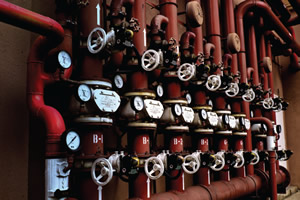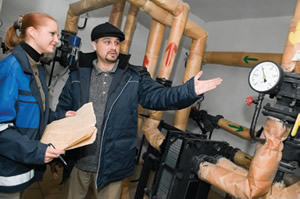Are You Code Compliant?

PHOTO © DMITRY KALINOVSKY/SHUTTERSTOCK
When it comes to environmental concerns, continuous improvement seems to be the name of the game. While some impetus for change may originate internally, external requirements are often at play. In fact, the scope of code requirements and other mandates can pose major challenges at the campus level. At the same time, an optimist might point to code compliance for the opportunities it brings.
“As protecting the environment becomes an increasingly important imperative, new environmental standards present higher ed institutions with the unique opportunity to lead by example in many ways,” says Tammy Fulop, vice president of energy and sustainability services at Schneider Electric. She says that these requirements will benefit institutions in the long run because energy efficiency plans reduce spending on utilities and encourage a focus on cleaner, renewable energy.
Comprehensive Responses
In responding to externally imposed requirements, institutions are embracing a number of approaches.
In Colorado, the state’s Renewable Portfolio Standard (RPS) requires investor-owned utilities to increase the percentage of renewable energy delivered to the grid by 30 percent by 2020.
“This has decreased the carbon factor that we use when accounting for purchased electricity, ultimately leading to fewer greenhouse gas emissions in our inventory,” says Jon Bortles, sustainability program manager in the department of facilities management at the University of Colorado Boulder.
His state also requires all state-assisted facilities undergoing new construction or major renovations to achieve Leadership in Energy and Environmental Design (LEED) Gold certification. The university has complied with this mandate and has certified 18 buildings to date with six certified as Platinum, Bortles notes. “The additional upfront investment required to meet this mandate should ultimately pay itself back over the life of the building through avoided utility costs,” he says.

PHOTO COURTESY OF NULL0
MEETS OR EXCEEDS EXPECTATIONS. The U.S. Department of Energy, through the Building Energy Codes Program (BECP) Resource Center, provides a comprehensive collection of information, resources and technical assistance designed to answer questions and address issues related to energy codes. The key to realizing the full benefits associated with building energy codes is through compliance verification. Effective compliance and enforcement unlocks deeper energy savings, reduced costs, higher building life-cycle value and minimized environmental impact.
In New York, LaGuardia Community College follows city building codes and a variety of other regulations. In addition, a state executive order mandates reduced energy consumption and promotion of recycling, among many other requirements. For new construction projects, staff members apply LEED Silver as a minimum standard.
“We have made major strides in replacing and or upgrading large old inefficient equipment such as chillers, boilers and air-handling units on campus,” says Shahir Erfan, vice president of Administration.
Two years ago, the college replaced old oil-fire boilers in its largest building. The new high-efficiency, natural gas boilers are equipped with automated controls that drastically reduce emissions. Chillers and several large air-handling units have also been retrofitted with variable frequency drives.
“This has not only reduced electrical consumption, but has improved the overall reliability of the service,” Erfan notes.
A century-old terra cotta façade on the largest building on campus is also being replaced with a new energy-efficient system. The design uses exterior sunshades to reduce solar heat gain while allowing natural light to penetrate the interior of the building. And most of the college’s public toilet facilities have been equipped with low-flow devices that reduce water consumption.
Colleges are responding similarly in Arkansas, where legislation enacted in 2009 provided direction to state agencies and public universities and colleges for environmentally sustainable construction. Among other things, it required agencies to reduce overall utility consumption by 30 percent by 2017 relative to fiscal year 2008. At Arkansas State University, campus leaders were working in that direction prior to legislative action, according to David Handwork, interim director of Facilities Management. At present, the university is exceeding the current state energy code minimum requirements and maintains a performance level that as an ongoing goal.
“Our institution specifies as a base standard LED lighting for all new construction, the highest efficiency hot water boilers, continuous air barrier for building envelopes, and continuous energy monitoring and benchmarking,” Handwork says. The Facilities Management team has also defined a retro-commissioning team for existing buildings, and uses ENERGY STAR Portfolio Manager for benchmarking campus building energy use.
For buildings not meeting or exceeding the energy benchmarking goals, the team is deployed to review existing operations and employ corrective action for improving energy use. Facilities management also has a staff member engaged on the ASHRAE 90.1 committee, serving as a voting member on the mechanical subcommittee. “This engagement provides owner input on energy code development,” Handwork says.
West Virginia University approaches compliance as a means for achieving a positive impact on campus safety and the to the international energy conservation code published by the ICC (International Code Council) that mandates use of enhanced insulating techniques and materials, as well as improvements to standard building materials such as windows and doors.

PHOTO © DMITRY KALINOVSKY/SHUTTERSTOCK
“These mandates are very effective in reducing energy needs, which in turn, decreases the energy needs of every building constructed using the new codes,” he says. “The result is less fuel burned, which greatly decreases harmful emissions from power producers.” He adds that while these codes tend to increase the initial costs related to some projects, the long-term gains will benefit the campus, the community and the environment.
Currently under development is an automated system to coordinate and control all building HVAC systems throughout the West Virginia campus. The system will be computer-controlled, and once active, will include existing and new buildings and equipment. When fully functional, the system is expected to yield significant long-term savings.
Moving Forward
To meet or exceed the various codes in place — as well as to address effectively new requirements that the future may hold — an aggressive approach seems to be the order of the day. Promoting awareness across campus can be a good first step. In fact students, faculty and staff can be the biggest advocates for sustainability on campus, according to Erfan. “They understand that colleges have a unique role to educate students and communities to be better environmental citizens,” he says. “They demand that we reduce energy consumption, recycle and reduce greenhouse gas emission. Partnership with concerned students, faculty and staff goes a long way in changing behavior not only on campus but in the surrounding communities.”
And of course, effective leadership regarding energy-related issues is a key.
“Leadership from the facilities management department is critical for success in meeting energy performance expectations,” Handwork says. “Facilities management leadership must be knowledgeable for the basic requirements of energy codes to provide accountability for designers and to provide action plans for meeting or exceeding energy performance requirements.”
Leaders are also well advised to be both adaptable and communicative with environmental considerations.
“At the end of the day we should all embrace the thought that today’s codes were developed as a solution to resolve catastrophic failures of previous codes, and there are still code changes every year,” Principe says. “We are all in this together, and good communication and cooperation can go a long way in protecting our people, property and the environment.”
This article originally appeared in the issue of .